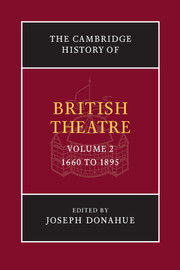Book contents
- Frontmatter
- Part I 1660 to 1800
- Part II 1800 to 1895
- 11 Introduction: the theatre from 1800 to 1895
- 12 Presence, personality and physicality: actors and their repertoires, 1776–1895
- 13 Theatres, their architecture and their audiences
- 14 Stage design from Loutherbourg to Poel
- 15 Theatre and mid-Victorian society, 1851–1870
- 16 Gendering Victorian theatre
- 17 Popular entertainment, 1776–1895
- 18 The Bells: a case study A ‘bare-ribbed skeleton’ in a chest
- 19 The new drama and the old theatre
- 20 1895 A critical year in perspective
- Bibliography
- Index
- References
11 - Introduction: the theatre from 1800 to 1895
from Part II - 1800 to 1895
Published online by Cambridge University Press: 28 March 2008
- Frontmatter
- Part I 1660 to 1800
- Part II 1800 to 1895
- 11 Introduction: the theatre from 1800 to 1895
- 12 Presence, personality and physicality: actors and their repertoires, 1776–1895
- 13 Theatres, their architecture and their audiences
- 14 Stage design from Loutherbourg to Poel
- 15 Theatre and mid-Victorian society, 1851–1870
- 16 Gendering Victorian theatre
- 17 Popular entertainment, 1776–1895
- 18 The Bells: a case study A ‘bare-ribbed skeleton’ in a chest
- 19 The new drama and the old theatre
- 20 1895 A critical year in perspective
- Bibliography
- Index
- References
Summary
1800 to 1843: tradition, innovation and regulation
Over the long period beginning with the restoration of King Charles II, the iron grip of the patent theatres on spoken-word performance, abetted by governmental oversight, had seriously impeded but not defeated the growth of theatres down through the late eighteenth century. Thanks in part to the vagueness of the laws related to burletta, as the new century began there were some ten theatres in operation in London, and by the end of the first decade fifteen.
The theatres in Drury Lane and Covent Garden were complemented by the opera house in the Haymarket, the King’s, the smaller theatre across the street, traditionally known as the Little Theatre (largely a summer venue), the Lyceum (built in 1771, converted to a theatre in 1794) and the Royalty in Wellclose Square, intermittently called the East London Theatre, burned in 1826 but swiftly rebuilt. Charles Dibdin’s hole-in-the-wall establishment, the Sans Souci, in the Strand near Southampton Street, lasted only from 1791 to 1796, but at his next venue, the New Sans Souci, in Leicester Square, he continued to charm audiences until 1804 with his idiosyncratic blend of songs and quasi-theatrical entertainment meanwhile writing a five-volume history of the English stage. Earlier on, he had composed ballad operas such as ThePadlock, in which he created the role of Mungo, at Drury Lane in 1768. His one-man entertainment, Private Theatricals; or, Nature in Nubibus, which opened the first Sans Souci, offered such songs as ‘The Sailor’s Consolation’, ‘Roses and Lilies’, and ‘The Soldier’s Last Retreat’. Dibdin’s prolific output, amounting to hundreds of songs, contributed abundantly to popular pleasures of the time.
- Type
- Chapter
- Information
- The Cambridge History of British Theatre , pp. 217 - 271Publisher: Cambridge University PressPrint publication year: 2004

